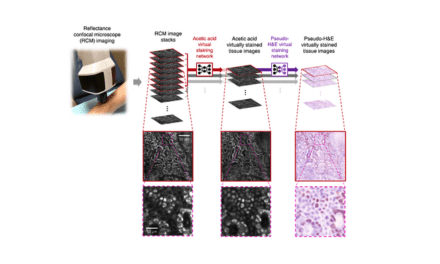By Renee DiIulio

If either or both cases are true, the BTA Stat Test, manufactured by BDS, a subsidiary of Polymedco Inc, and distributed by Mentor Corp, could offer a potential solution. The point-of-care test is indicated for the detection of recurrent bladder cancer and has been found in studies to be significantly better at detection than the current non-invasive standard of cytology. The test has even been approved for home use, although few physicians choose to prescribe it in this fashion.
High Recurrence Rate Requires Frequent Screening
Bladder cancer is the sixth most commonly diagnosed malignancy in the United States, according to the National Cancer Institute. The American Cancer Society estimates that roughly 57,400 new cases will be diagnosed this year and 12,500 Americans will die of the disease. Men are 2.5 times more likely than women to be diagnosed with the malady, and the incidence increases among those 60 years and older, bad news for the aging baby boomer population.
However, Grant Friedrich, a Mentor representative, notes that if the cancer is detected early, the 5-year survival rate is 90%; if found after it has metastasized, it drops to 10%. The recurrence rate is over 75%, and approximately eight of every ten patients with newly diagnosed bladder cancer have a tumor recurrence within the first year, important statistics for the more than 600,000 patients in the United States who have survived bladder cancer.
According to the National Cancer Institute, “more than 90% of bladder cancers begin in the transitional cells,” a type of cancer referred to as transitional cell carcinoma. About 8% of bladder cancer patients have squamous cell carcinomas. Both types occur in the bladder wall. Those tumors detected too late have become invasive cancer, growing through the lining and into the muscular wall of the bladder. From there, the cancer may spread to other organs, including the uterus, vagina, prostate gland, and abdomen. Once it reaches the lymph nodes, other areas, such as the lungs, liver, and bones, are at risk. At this late stage, the cancer becomes even more difficult to treat, and survival rates decline. Only 5% of patients with metastasized bladder cancer live 2 years after diagnosis. For this reason, continuous screening for the recurrence of bladder cancer is recommended.

Follow-Up Care Lacking
It is generally suggested that patients who have been treated for non-invasive bladder cancer undergo cytoscopy every 3 to 6 months for the first 3 years and once a year after that. In the April 2003 issue of the Journal of the National Cancer Institute, researchers at Memorial Sloan-Kettering Cancer Center found that only 40% of patients with non-invasive bladder cancer had undergone all of the recommended five screenings. Roughly 18% had had fewer than two examinations in the 3-year period since diagnosis, an approach researchers dubbed “low-intensity surveillance.”
The team was not able to determine why patients did not receive the suggested follow-up care but did note that patients who were more likely to have low-intensity screening included those with better prognoses, those with advanced age, those in minority groups, and those with other serious illnesses. No differences were noted among the doctors caring for these patients.
The researchers did put forth some theories, including the patients’ desire to avoid invasive and potentially unpleasant cytoscopy and physicians’ belief that the hassle of the examination outweighs its benefits.
Cytoscopy permits the physician to see inside the patients’ bladder through a thin, tube-like instrument bearing a very tiny camera and inserted through the urethra. For this procedure, which is commonly performed in the doctor’s office, the patient may be offered local anesthesia or light sedation, in addition to the topical anesthetic gel used, to decrease discomfort.
Immunoassay Makes Screening Simple and Painless
Although the BTA Stat Test is not intended as a replacement for cytoscopy, studies have found that it offers better detection than urine cytology, a urinalysis that looks for indications of malignancy, such as cancer cells, at the microscopic level.
The BTA Stat Test is a single-step immunoassay that requires five drops of urine and is completed within 5 minutes. No pretreatment of the urine sample is necessary, but the sample must be either voided or collected from a catheterized patient in a clean urine cup free of preservatives or fixtures.
Intended for qualitative detections of bladder tumor-associated antigen, the test uses two different monoclonal antibodies (MAbs) to detect the presence of the antigen in the urine sample.
“Bladder tumor-associated antigen is a protein produced by tumor cells in the bladder and excreted into the urine,” says Jennifer Becking, marketing associate with Mentor. Bladder tumor-associated antigen has been identified as human complement factor H-related protein (hCFHrp), similar to human complement factor H (hCFH).
Research has shown that several human bladder cancer cell lines produce hCFHrp in cell culture, although normal epithelial cell lines do not. Furthermore, in situ hybridization in tumor specimens revealed that hCFHrp was produced by cancer cells and macrophages but not by normal epithelia.
According to the product literature, the MAbs used in the BTA Stat Test were generated against urine components from patients with histologically confirmed bladder cancer. Each MAb specifically binds to a different epitope on the target antigen (hCFHrp); one serves as the hCFHrp capture agent and the other is conjugated to colloidal gold and serves as the reporter molecule if hCFHrp is present in the specimen.
When the five drops of urine are added to the sample well, they react with the colloidal gold–conjugated reporter antibody. “If antigen is present, it will interact with the conjugate to form an immune complex as the reaction mixture flows through the membrane, which contains zones of immobilized antibodies. In the patient zone or window, antigen-conjugate complexes are trapped by the capture antibody, forming a visible line. In the absence of the antigen in the patient urine, no visible line will form,” says Becking.
More simply, a line in the patient response indicator window is positive; no line is negative. “It is important to note that even a faint line indicates a positive response,” Becking stresses.
The control zone or window should always show a line to indicate to the operator that the device is working properly. This works because the zone contains an immobilized goat anti-mouse IgG-specific antibody that captures the conjugated antibody independently of the presence or absence of the antigen, thereby always producing a line. If no line is present, it has not worked properly, and the test should be run again with a new device.
Simple and painless, the BTA Stat Test can be performed almost anywhere: in the physician’s office, the laboratory, or the patient’s home, although many doctors have yet to prescribe it for private use. The test was originally cleared for marketing by the Food and Drug Administration in 1997 and for prescription home use in 1998. It was the first tumor marker approved for use in the home with a prescription and the first granted Clinical Laboratory Improvement Amendments (CLIA) Waived Status. It is reimbursed in a majority of states.
Studies Find Sensitivity Greater Than That of Cytology
Although it is simple, the test is not fail-safe, and both false-positives and false-negatives are possible, with false-positives more likely. Becking notes that positive results have been seen with other conditions such as renal disease, including kidney stones and cancer. Other possibilities include concurrent genitourinary infection or inflammation, urinary calculi, recent trauma to the bladder or urinary tract, and effects from radiation therapy, intravesical agents, or systemic chemotherapy. It may even be that the test was conducted incorrectly, with too much time elapsing before it was read.
Says Becking, “If the test is positive, something is abnormal.” Friedrich adds that those patients who have a positive result on the BTA Stat Test but a negative result on cytoscopy are frequently watched more closely. “Instead of returning to the doctor’s office in 6 months, they may be asked to come back in 3.”
Research by MP Raitanen et al published in Urology (2001: 57 (4): 680-684) found that of 46 patients who had a true false-positive BTA Stat Test, 7% had a recurrence at the next follow-up cytoscopy. The study concluded that patients with a “positive BTA Stat Test result and negative cytoscopic findings have about a 16% risk of an undetected recurrence.” Though it is not a high risk, it may justify an additional beneficial follow-up visit, whereas none may have been required before.
False-negatives may result from very low-stage/grade tumors, a corrupted urine specimen, or incorrect interpretation (the operator may have deemed a faint line to be a negative result), although the control window is intended to help eliminate such errors. Urine cytology has been found to be more specific than the BTA Stat Test and to yield fewer false-positive results; however, it is also more likely to yield a false-negative than the BTA Stat Test.
In another report published in the British Journal of Cancer (2001: 85, 552-556), MP Raitanen et al revealed that of the 97 patients eligible for analysis, the BTA Stat Test indicated a positive result for 73 cases (75.3%) whereas cytology was positive for only 20 (20.6%).
Another study conducted by Gutierrez Banos et al and published in Urology International (2001: 66 (4): 185-190) also found the BTA Stat Test to be more sensitive than cytology (72.37% versus 69.75%).
A multi-center study led by Dr. Michael Sarsody of the University of Texas Health Science Center at San Antonio confirmed that the sensitivity of the BTA Stat Test in detecting cancer at various levels of tumor stage and grade is statistically superior to that of cytology. In 1997’s The Doctor’s Guide, Sarsody says, “…the BTA Stat Test should allow for the replacement of cytology in most cases and allow decisions previously based on cytology to be made more quickly. For a physician’s office or hospital-based urology practice, using the BTA Stat Test means clinical decisions can be made before cytoscopy rather than after.”
For the patient hoping to avoid the examination, that is good news — perhaps good enough to encourage a return to the doctor’s office for follow-up care that may prolong his or her life.
For additional information, contact Jennifer Becking, marketing associate, Mentor Corp, Santa Barbara, CA, (805) 879-6145, fax: (805) 879-6166, [email protected], or Grant Friedrich, Mentor Urology, Healthcare Marketing, Mentor Corp (805) 879-6314, fax: (805) 879-6166, [email protected].
Renee DiIulio is a contributing writer for Clinical Lab Products.




